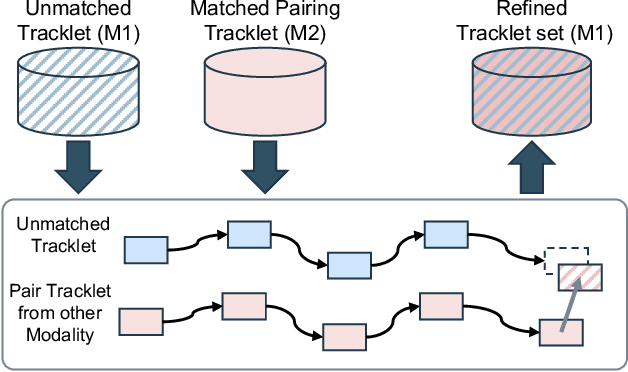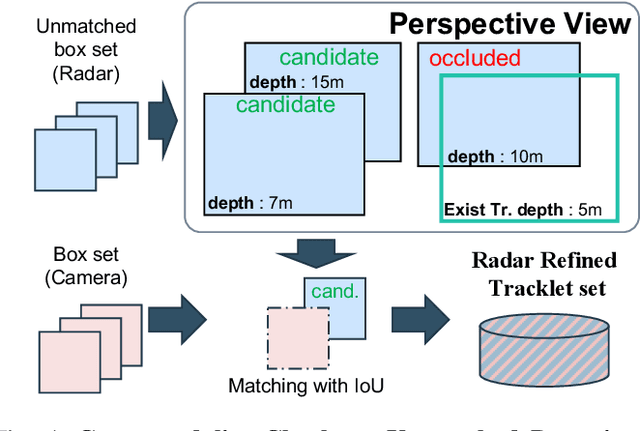Hsiang-Wei Huang
PackDiT: Joint Human Motion and Text Generation via Mutual Prompting
Jan 27, 2025



Abstract:Human motion generation has advanced markedly with the advent of diffusion models. Most recent studies have concentrated on generating motion sequences based on text prompts, commonly referred to as text-to-motion generation. However, the bidirectional generation of motion and text, enabling tasks such as motion-to-text alongside text-to-motion, has been largely unexplored. This capability is essential for aligning diverse modalities and supports unconditional generation. In this paper, we introduce PackDiT, the first diffusion-based generative model capable of performing various tasks simultaneously, including motion generation, motion prediction, text generation, text-to-motion, motion-to-text, and joint motion-text generation. Our core innovation leverages mutual blocks to integrate multiple diffusion transformers (DiTs) across different modalities seamlessly. We train PackDiT on the HumanML3D dataset, achieving state-of-the-art text-to-motion performance with an FID score of 0.106, along with superior results in motion prediction and in-between tasks. Our experiments further demonstrate that diffusion models are effective for motion-to-text generation, achieving performance comparable to that of autoregressive models.
SAMURAI: Adapting Segment Anything Model for Zero-Shot Visual Tracking with Motion-Aware Memory
Nov 18, 2024Abstract:The Segment Anything Model 2 (SAM 2) has demonstrated strong performance in object segmentation tasks but faces challenges in visual object tracking, particularly when managing crowded scenes with fast-moving or self-occluding objects. Furthermore, the fixed-window memory approach in the original model does not consider the quality of memories selected to condition the image features for the next frame, leading to error propagation in videos. This paper introduces SAMURAI, an enhanced adaptation of SAM 2 specifically designed for visual object tracking. By incorporating temporal motion cues with the proposed motion-aware memory selection mechanism, SAMURAI effectively predicts object motion and refines mask selection, achieving robust, accurate tracking without the need for retraining or fine-tuning. SAMURAI operates in real-time and demonstrates strong zero-shot performance across diverse benchmark datasets, showcasing its ability to generalize without fine-tuning. In evaluations, SAMURAI achieves significant improvements in success rate and precision over existing trackers, with a 7.1% AUC gain on LaSOT$_{\text{ext}}$ and a 3.5% AO gain on GOT-10k. Moreover, it achieves competitive results compared to fully supervised methods on LaSOT, underscoring its robustness in complex tracking scenarios and its potential for real-world applications in dynamic environments. Code and results are available at https://github.com/yangchris11/samurai.
GTA: Global Tracklet Association for Multi-Object Tracking in Sports
Nov 12, 2024Abstract:Multi-object tracking in sports scenarios has become one of the focal points in computer vision, experiencing significant advancements through the integration of deep learning techniques. Despite these breakthroughs, challenges remain, such as accurately re-identifying players upon re-entry into the scene and minimizing ID switches. In this paper, we propose an appearance-based global tracklet association algorithm designed to enhance tracking performance by splitting tracklets containing multiple identities and connecting tracklets seemingly from the same identity. This method can serve as a plug-and-play refinement tool for any multi-object tracker to further boost their performance. The proposed method achieved a new state-of-the-art performance on the SportsMOT dataset with HOTA score of 81.04%. Similarly, on the SoccerNet dataset, our method enhanced multiple trackers' performance, consistently increasing the HOTA score from 79.41% to 83.11%. These significant and consistent improvements across different trackers and datasets underscore our proposed method's potential impact on the application of sports player tracking. We open-source our project codebase at https://github.com/sjc042/gta-link.git.
ToddlerAct: A Toddler Action Recognition Dataset for Gross Motor Development Assessment
Aug 31, 2024Abstract:Assessing gross motor development in toddlers is crucial for understanding their physical development and identifying potential developmental delays or disorders. However, existing datasets for action recognition primarily focus on adults, lacking the diversity and specificity required for accurate assessment in toddlers. In this paper, we present ToddlerAct, a toddler gross motor action recognition dataset, aiming to facilitate research in early childhood development. The dataset consists of video recordings capturing a variety of gross motor activities commonly observed in toddlers aged under three years old. We describe the data collection process, annotation methodology, and dataset characteristics. Furthermore, we benchmarked multiple state-of-the-art methods including image-based and skeleton-based action recognition methods on our datasets. Our findings highlight the importance of domain-specific datasets for accurate assessment of gross motor development in toddlers and lay the foundation for future research in this critical area. Our dataset will be available at https://github.com/ipl-uw/ToddlerAct.
Boosting Online 3D Multi-Object Tracking through Camera-Radar Cross Check
Jul 18, 2024



Abstract:In the domain of autonomous driving, the integration of multi-modal perception techniques based on data from diverse sensors has demonstrated substantial progress. Effectively surpassing the capabilities of state-of-the-art single-modality detectors through sensor fusion remains an active challenge. This work leverages the respective advantages of cameras in perspective view and radars in Bird's Eye View (BEV) to greatly enhance overall detection and tracking performance. Our approach, Camera-Radar Associated Fusion Tracking Booster (CRAFTBooster), represents a pioneering effort to enhance radar-camera fusion in the tracking stage, contributing to improved 3D MOT accuracy. The superior experimental results on the K-Radaar dataset, which exhibit 5-6% on IDF1 tracking performance gain, validate the potential of effective sensor fusion in advancing autonomous driving.
RT-Pose: A 4D Radar Tensor-based 3D Human Pose Estimation and Localization Benchmark
Jul 18, 2024Abstract:Traditional methods for human localization and pose estimation (HPE), which mainly rely on RGB images as an input modality, confront substantial limitations in real-world applications due to privacy concerns. In contrast, radar-based HPE methods emerge as a promising alternative, characterized by distinctive attributes such as through-wall recognition and privacy-preserving, rendering the method more conducive to practical deployments. This paper presents a Radar Tensor-based human pose (RT-Pose) dataset and an open-source benchmarking framework. The RT-Pose dataset comprises 4D radar tensors, LiDAR point clouds, and RGB images, and is collected for a total of 72k frames across 240 sequences with six different complexity-level actions. The 4D radar tensor provides raw spatio-temporal information, differentiating it from other radar point cloud-based datasets. We develop an annotation process using RGB images and LiDAR point clouds to accurately label 3D human skeletons. In addition, we propose HRRadarPose, the first single-stage architecture that extracts the high-resolution representation of 4D radar tensors in 3D space to aid human keypoint estimation. HRRadarPose outperforms previous radar-based HPE work on the RT-Pose benchmark. The overall HRRadarPose performance on the RT-Pose dataset, as reflected in a mean per joint position error (MPJPE) of 9.91cm, indicates the persistent challenges in achieving accurate HPE in complex real-world scenarios. RT-Pose is available at https://huggingface.co/datasets/uwipl/RT-Pose.
VersaT2I: Improving Text-to-Image Models with Versatile Reward
Mar 27, 2024Abstract:Recent text-to-image (T2I) models have benefited from large-scale and high-quality data, demonstrating impressive performance. However, these T2I models still struggle to produce images that are aesthetically pleasing, geometrically accurate, faithful to text, and of good low-level quality. We present VersaT2I, a versatile training framework that can boost the performance with multiple rewards of any T2I model. We decompose the quality of the image into several aspects such as aesthetics, text-image alignment, geometry, low-level quality, etc. Then, for every quality aspect, we select high-quality images in this aspect generated by the model as the training set to finetune the T2I model using the Low-Rank Adaptation (LoRA). Furthermore, we introduce a gating function to combine multiple quality aspects, which can avoid conflicts between different quality aspects. Our method is easy to extend and does not require any manual annotation, reinforcement learning, or model architecture changes. Extensive experiments demonstrate that VersaT2I outperforms the baseline methods across various quality criteria.
VideoBadminton: A Video Dataset for Badminton Action Recognition
Mar 19, 2024Abstract:In the dynamic and evolving field of computer vision, action recognition has become a key focus, especially with the advent of sophisticated methodologies like Convolutional Neural Networks (CNNs), Convolutional 3D, Transformer, and spatial-temporal feature fusion. These technologies have shown promising results on well-established benchmarks but face unique challenges in real-world applications, particularly in sports analysis, where the precise decomposition of activities and the distinction of subtly different actions are crucial. Existing datasets like UCF101, HMDB51, and Kinetics have offered a diverse range of video data for various scenarios. However, there's an increasing need for fine-grained video datasets that capture detailed categorizations and nuances within broader action categories. In this paper, we introduce the VideoBadminton dataset derived from high-quality badminton footage. Through an exhaustive evaluation of leading methodologies on this dataset, this study aims to advance the field of action recognition, particularly in badminton sports. The introduction of VideoBadminton could not only serve for badminton action recognition but also provide a dataset for recognizing fine-grained actions. The insights gained from these evaluations are expected to catalyze further research in action comprehension, especially within sports contexts.
Exploring Learning-based Motion Models in Multi-Object Tracking
Mar 16, 2024



Abstract:In the field of multi-object tracking (MOT), traditional methods often rely on the Kalman Filter for motion prediction, leveraging its strengths in linear motion scenarios. However, the inherent limitations of these methods become evident when confronted with complex, nonlinear motions and occlusions prevalent in dynamic environments like sports and dance. This paper explores the possibilities of replacing the Kalman Filter with various learning-based motion model that effectively enhances tracking accuracy and adaptability beyond the constraints of Kalman Filter-based systems. In this paper, we proposed MambaTrack, an online motion-based tracker that outperforms all existing motion-based trackers on the challenging DanceTrack and SportsMOT datasets. Moreover, we further exploit the potential of the state-space-model in trajectory feature extraction to boost the tracking performance and proposed MambaTrack+, which achieves the state-of-the-art performance on DanceTrack dataset with 56.1 HOTA and 54.9 IDF1.
A Density-Guided Temporal Attention Transformer for Indiscernible Object Counting in Underwater Video
Mar 06, 2024



Abstract:Dense object counting or crowd counting has come a long way thanks to the recent development in the vision community. However, indiscernible object counting, which aims to count the number of targets that are blended with respect to their surroundings, has been a challenge. Image-based object counting datasets have been the mainstream of the current publicly available datasets. Therefore, we propose a large-scale dataset called YoutubeFish-35, which contains a total of 35 sequences of high-definition videos with high frame-per-second and more than 150,000 annotated center points across a selected variety of scenes. For benchmarking purposes, we select three mainstream methods for dense object counting and carefully evaluate them on the newly collected dataset. We propose TransVidCount, a new strong baseline that combines density and regression branches along the temporal domain in a unified framework and can effectively tackle indiscernible object counting with state-of-the-art performance on YoutubeFish-35 dataset.
 Add to Chrome
Add to Chrome Add to Firefox
Add to Firefox Add to Edge
Add to Edge